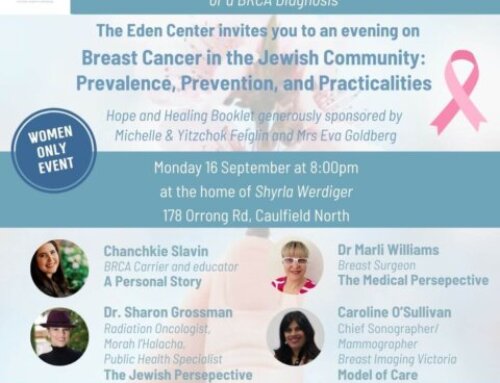Halachic Infertility describes the condition of a woman who ovulates before she has been to the mikveh, making marital relations with her husband impossible at the optimal (or perhaps only) time for fertility. This may be caused by a woman who has extended bleeding or spotting, “early” ovulation, a misread of problematic bedikah or stain colors or another relevant medical issue, all of which delay her ability to immerse in a mikveh at the proper time. As a Fertility Consultant who works with halachic infertility, I have found several treatment options.
Happily, the most common and basic issue to address is women who become halachically infertile as a result of confusion about problematic bedikot or stain colors. Many women may not be aware that for both bedikot and stains, there is a range of halachically permissible colors. Seeking out a teacher, Rav or yoetzet with whom to consult and to make sure that the color of her vaginal and cervical fluids (sometimes referred to as “discharge” or “mucus”) is or is not problematic, can alleviate waiting extra, unnecessary time before immersion. (The Eden Center also runs a course called “Taharah in Living Color” in which women are taught about stains and colors. We are happy to bring it to any community online or in person.)
In the event of truly problematic colors and stains due to prolonged bleeding or spotting, there are many halachic solutions that can alleviate the problem. These include; eliminating the moch, limiting bedikot to the minimum required amount (the hefsek taharah and an additional exam on both the first day and the last day of the shivah neki’im), the wearing of colored underwear during these 7 days, allowing those who consider stains on toilet paper to be problematic to ignore such stains, using alternative insemination before the scheduled date of the mikveh, permitting a reduction of minimum days required before the hefsek taharah and more. A competent halachic authority should be consulted.
A second option that can assist a woman challenged by halachic infertility is changing her use of menstrual hygiene products.
I recommend to all of my clients to avoid all disposable products. There are numerous reasons for this, including the fact that they contain dioxins and toxins which are known to cause cancer, as well as drying agents, allergens and chemicals that are dangerous to the reproductive system. Tampons, which sit inside of the reproductive organs, are the most harmful, causing micro tears and, because they are neither sterile nor able to be sterilized, introducing bacteria into the vaginal canal and other reproductive organs. I recommend a complete switch to either cloth menstrual products (such as cloth pads, “period” underwear and cloth labial tampons, which are not inserted into the vaginal canal), menstrual cups or a combination of the above.
Cloth menstrual products are softer and gentler on the delicate vaginal labia and do not contain any of the glues and other harmful chemical components that are so often found in their disposable counterparts. They can easily be sterilized by washing in boiling water and can also be purchased or created using organic materials for those with suspected sensitivities. Menstrual cups are made either from medical grade silicone, plastic or latex, and can be purchased online from many different companies worldwide. They, too, can be sterilized by boiling in water for 3-10 minutes (depending on each manufacturer’s instructions). The menstrual cup is inserted low into the vagina (as opposed to tampons, which sit high and close to the cervix) and should not interfere with an IUD for those women who use it for birth control. Because menstrual cups collect (rather than absorb) menstrual flow, and because they are made from materials that inhibit the growth of bacteria, they are very gentle on the delicate vaginal tissues and flora.
Menstrual cups are held in place within the vagina by the vaginal muscles and a light natural suction created by the cup and the vaginal wall. It is hypothesized that it is this light suction which gently draws out and helps to complete the menstrual flow in some women, so that there will be lessened or no spotting following completion of the menstrual period. This efficiency and reduced spotting may allow women to begin counting their seven “blood free” days sooner than they were previously able. It is also important to note that, when the cup is inserted properly, it is unlikely to be felt in the vagina by the user. The cup can typically remain in the vagina for up to 12 hours before being emptied (check manufacturer’s instructions which range from 6-24 hours), cleaned and reinserted and typically carries lower risk of toxic shock syndrome than tampons. Menstrual cups can last for up to 10 years (perhaps longer) and are therefore significantly less expensive than disposable products. Of course, they (and other reusable products) are also the preferred environmental option because they eliminate the waste generated by disposable products.
The problem of an underlying medical condition which could cause halachic infertility is slightly more challenging to solve. Typically, I will begin by teaching women the basics of symptom-thermal Fertility Awareness Based Methods (FAM/FABM). FABM are based on charting two main fertility indicators: cervical fluid and basal body temperature. Because cervical fluid noticeably changes with the increase or decrease of naturally occurring fertility hormones, it is possible for a woman to recognize fertile quality cervical fluid (sometimes called cervical mucus or vaginal discharge) and to time intercourse during the time of the most fertile quality to maximize the chances of fertility. It is also possible for a woman to indicate possible halachic infertility to her health care practitioner if she is experiencing and charting fertile quality cervical fluid followed by non-fertile cervical fluid prior to her immersion in the mikveh. The second indicator is the basal body temperature (or waking temperature) that a woman can also monitor herself. This temperature will allow the woman to know that she has already ovulated only after the fact, so it is not a predictor of impending ovulation. Women will then cross reference their cervical fluid signs with their basal body temperatures to confirm that ovulation has indeed occurred. A third optional indicator may be tracked, which is cervical position and cervical os dilation. It is not necessary to track this third factor to use the method, but it is highly recommended and takes only a few seconds of time a day. Secondary fertility signs that may also be charted with the method are middleschmertz (or ovulatory cramping), headaches, bloating sensation, acne, or other personal indicators which vary from woman to woman. Many of these signs have the added benefit of being helpful indicators for establishing a possible vesset.
Once the woman is proficient in charting her cycles, using the above information, we are typically able to confirm ovulation pre-mikveh in halachic infertility. Sometimes we are able to see that ovulation is not taking place at all (anovulation). Sometimes this is the case even when the woman is experiencing fertile quality cervical fluid and/or having periods. There are many herbs that may assist in either anovulation or halachic infertility and have been used for countless years by experienced herbalists and fertility specialists. I recommend a wide variety of herbs in my practice that can assist, depending on what I feel may be the underlying cause of the issue. Common potential medical problems that may benefit from herbal medicine are abnormally long or short cycles, PCOS or Endometriosis and short luteal phase (lack of requisite number of days between ovulation/implantation and the beginning of the period to maintain a pregnancy). It is impossible to recommend the correct herb for each woman, unless all relevant factors have been recorded, observed and considered by a qualified observer, using their FABM charts and information gleaned at the intake appointment.
It is important to note that there is much information about many different herbs that can be used in treatment on the internet and in herbals. Among those that may be recommended are vitex, dong quai, red raspberry leaf, red clover, soy isoflavones, wild yam root, nettles, trace minerals and vitamin supplements. There are additional herbs for fertility related problems, such as thyroid function abnormalities or malnourishment, that may also cause early ovulation, anovulation and more.
It is critical that women seek proper care and guidance when formulating their halachic infertility correction protocol. Improper use of herbs can create complications ranging from inaction to severe negative reaction when not used correctly or used in incorrect combinations with other herbs or pharmaceuticals. With the right guidance, halachic infertility can often be overcome naturally and through non-hormonal options.
Rivkah Asoulin is a Woman’s Fertility Consultant and the founder of Wise Woman Fertility. She is also the founder and executive director of Ancient Roots Israel, the first international conference and community in Israel. She can be reached for private consultation or public speaking engagements via her website.








Leave A Comment